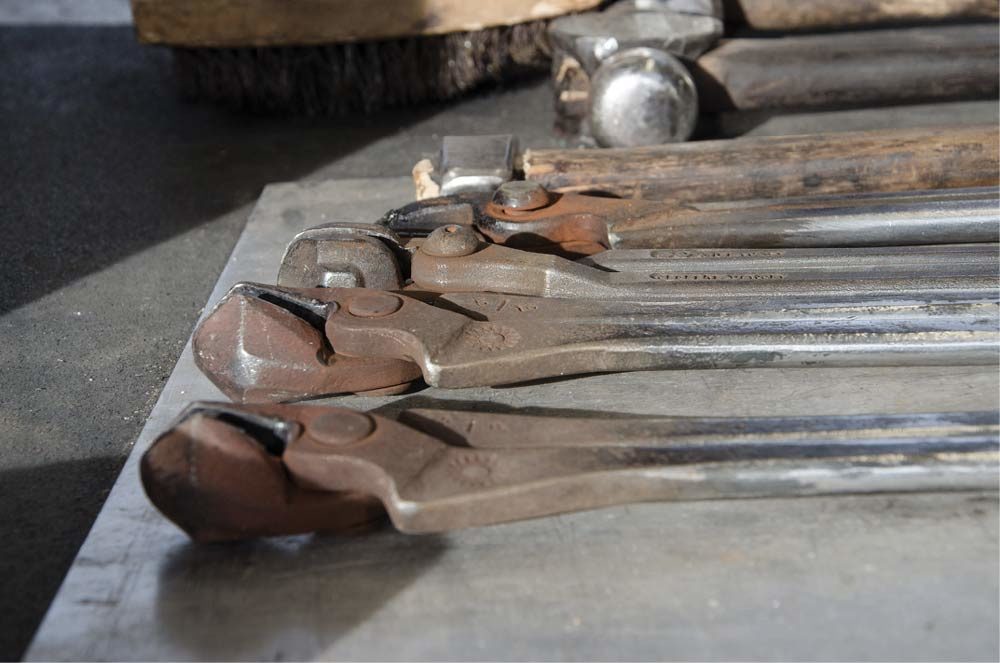
Choosing the Right Hardware for Your Toolbox
This article was originally published August 4, 2019 and has been updated.
Pictured Above: There are a number of tools that will make your job easier but not all of them are necessary to get the job done. Choosing tools wisely will help keep costs low.
Farrier Takeaways
- The types of horses that you work on will determine the tools you need.
- Many tools are desirable but aren’t necessary when budgets are tight.
- Acquire tools that properly fit your hands to avoid repetitive injuries.
The quality of equipment you have will play an essential role in the quality of work you will deliver as a farrier. Equipment also will be one of your main investments when you are just starting out. With so many options and prices that run the gamut, how do you decide what to purchase? Three successful farriers with offer their insight on making smart tool and equipment purchases.
“Knowledge and education are the first tools for a farrier,” says Dan Bradley, a member of the International Horseshoeing Hall of Fame and who worked for many years as a representative for GE Forge & Tool of Grover Beach, Calif.
As for hardware, Bradley says, “To go out and shoe a horse, you basically need an anvil, a rounding hammer, a knife, a nipper or some kind of cutting tool, rasp, some nails and a driving hammer. That’s what new farriers need,” he says. “They don’t need grinders and high-end equipment to start out with.”
Donald Jones, another member of the International Horseshoeing Hall of Fame and the long-time owner of NC Tool Co. in Pleasant Garden, N.C., offers a similar list for new farriers.
He recommends a hoof knife, nippers, rasp, clincher, driving hammer, rounding hammer, crease nail puller, clinch cutter, clinch block, pull-offs, a forge for modifying shoes, an anvil or a stall jack, an anvil stand with a spring vise and a hoof stand and cradle.
“If you’re going to shoe every day,” Jones says, “you need those tools to make the job easier.”
Tom McNew, who owns and operates Lookout Mountain School of Horseshoeing in Gadsden, Ala., with his son Lane, adds to the list. He says new farriers should get off on the right foot by using a hoof gauge and a wing divider — tools for measuring a hoof and properly fitting a shoe — and recommends a good apron and a toolbox on casters.
McNew, who began shoeing in 1960, remembers farriers treating all hooves alike during his early years. Now, student farriers are taught that every foot is different, he says, and accurate measurements help ensure well-fitting shoes.
“Imagine if a carpenter tried to build a house without a tape measure,” he says. “How would that turn out?”
Bradley says the tools new farriers need can be influenced by the horses they are working on.
“If they’re starting out on their own and soliciting work, they’re going to do a lot of backyard horses,” he says. “If they start out apprenticing or riding with somebody, it will depend on the discipline that person is doing, from Thoroughbreds to gaited horses or whatever. The young farrier will see what is needed to work in that field.”
Need vs. Nice-to-have
Bradley says new farriers need to determine a realistic budget and stay within it. Jones agrees, noting that some tools might be desirable, but are not absolutely necessary while budgets are tight.
For example, Jones says, “You don’t have to have a clinch cutter, you can file the clinch off with a rasp, then pull the shoe. And you don’t need a clincher. You can clinch the nails with a hammer.
“You can just bend the nail over and flatten it against the hoof with a hammer, but that requires more skill than using a clincher. You’re hitting the side of the horse’s foot with a glancing blow, and you need to be really accurate.”
A new farrier can also do without a crease nail puller.
“You can take pull-offs, carefully work them under the shoe and raise the shoe a little bit,” Jones says. “That will pull the nail back out. Then you can pull it out with your shoe-puller. It takes a bit of skill to work the shoe up.”
An anvil is another item that isn’t truly necessary, according to Jones.
“You can use a stall jack,” he says. “The downside of that is you’re bent over, working low on a stall jack, as opposed to an anvil.”
Some farriers have both an anvil and a stall jack, which can be used to work around a horse while doing hoof work in a stall. “It has its place,” Jones says.
Although a hoof stand might not be necessary, Jones recommends them.
“I always used a hoof stand to set the front feet on. Some people just use their knee, but that takes a lot of skill and a lot of energy,” he says. “Now, there are hoof stands with cradles you can put on or take off. They’re nice to have; they can take some of the weight off you while you work.”
New farriers will be reassured to hear that they don’t need a large, expensive shoeing rig — just a vehicle that is neat and clean.
“It doesn’t really matter what you drive up in,” Bradley says. “People aren’t really impressed by that. But they will be impressed if you step out of a truck and 10 pounds of Taco Bell wrappers and two six-packs fall out.”
When to Save or Splurge
McNew says high-quality tools help a farrier work efficiently, but adds, “High-dollar tools are nice but are not always necessary.” That’s because, for some types of tools, less expensive brands often offer the same quality as more expensive options, he says.
However, he strongly recommends buying the highest-quality nippers you can find, regardless of the price.
“You need to be ready to trim that big horse with really hard feet,” he says.
To get the most from your tool investment, McNew suggests shopping at horseshoeing clinics, where tools are often on sale at sizable discounts.
Bradley says new farriers will most likely destroy everything they have. “When they first start out, they tend to make mistakes,” he says. “They’ll start out cutting wrong or sharpening a knife wrong, but they learn how to do it right. Then they start moving into better quality equipment, from anvils to nippers.
The good news is that new farriers on a tight budget don’t need to worry about starting out with substandard equipment, according to Jones, who began shoeing in the early 1960s.
“There are a lot of high-quality tools out there in different price ranges,” he says.
Jones advises acquiring tools that properly fit you ad your preferences. “If you’re cold-shoeing, you need to go with a heavier hammer,” he says. “It will be easier on your wrist and arm.”
Jones recommends an anvil in the 70-pound range, saying it’s easier to handle and will accommodate most shoeing tasks as well as larger anvils.
He suggests mounting an anvil on a stand, with the top of the anvil about even with your wrist when you stand straight up. That set-up helps farriers avoid raising the arm too high or needing to bend over when working on the anvil, thus saving wear and tear on their bodies over time.
Avoid working on an anvil set on a truck tailgate, Jones warns. “That puts the anvil too high,” he says. “Several of us in my area did that, and every one of us got tendonitis.
He also recommends using an anvil stand fitted with a foot pedal that operates a spring-loaded vise.“That’s handy for holding a shoe when you’re hot shoeing or want to use two hands to hold a drill or something like that,” Jones says.


